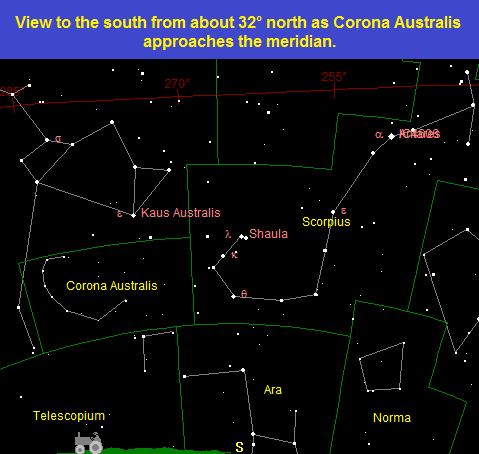¡SkyCaramba! Weekly astronomy blog for the week ending July 12, 2014
Not much is said about a circlet of stars the ancient Greeks saw as a wreath. Even so, the stars of this wreath  are still recognized as a constellation. The International Astronomical Union made it one of the official 88 constellations 18 centuries after Ptolemy put it on his list. The wreath is called Corona Australis, or the southern crown, now.
are still recognized as a constellation. The International Astronomical Union made it one of the official 88 constellations 18 centuries after Ptolemy put it on his list. The wreath is called Corona Australis, or the southern crown, now.
If you want to think of it as a crown, you can think of it as the one Chiron the centaur wore. The earliest Greek legends say he was wiser even than the gods. He formed the constellations and taught man how to understand the stars.
You could also think of it as the crown Dionysus put in the sky after he freed his mother from Hades. However, that legend is also linked to Corona Borealis, or the northern crown.
 For those who prefer to think of these stars as a wreath, the story of Bacchus may do. Stimula, a mortal woman pregnant with the god Jupiter’s child, asked him to appear to her in his full splendor. Unfortunately, she couldn’t tolerate the experience and burned to a crisp. However, her child survived. Bacchus became the god of wine and placed a wreath in the sky to honor his mother many years later.
For those who prefer to think of these stars as a wreath, the story of Bacchus may do. Stimula, a mortal woman pregnant with the god Jupiter’s child, asked him to appear to her in his full splendor. Unfortunately, she couldn’t tolerate the experience and burned to a crisp. However, her child survived. Bacchus became the god of wine and placed a wreath in the sky to honor his mother many years later.
Arab people of centuries ago called the constellation a turtle, a tent, or an ostrich nest.
The ancient Chinese also thought of it as a turtle.
To a far southern African tribe, the constellation’s stars were a council of people sitting together around a fire.
 Some aborigines saw them as a boomerang.
Some aborigines saw them as a boomerang.
Corona Australis cannot be seen at high northern latitudes. In middle northern latitudes, one will find the dim stars left of Scorpio and below Sagittarius in the south on summer nights. Its brightest star is called Alphekka Meridiana which means Alphecca South. The original Alphecca is the bright star in Corona Borealis. Binoculars will help you find Corona Australis.
¡SkyCaramba!